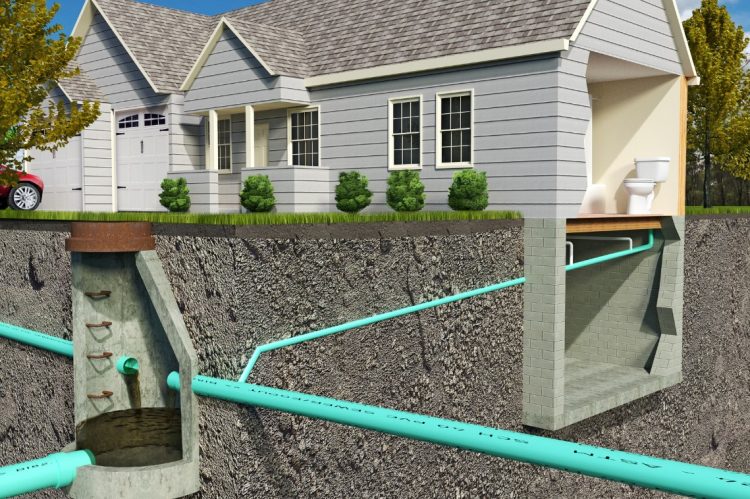Septic systems are essential for homes not connected to municipal sewage systems. Potential home buyers from properties with public sewers need to know there is a difference. Properly maintaining these systems is crucial to ensure their longevity and prevent costly repairs.
Regular septic system maintenance, inspection, and tank pumping can help prevent backups, leaks, and potential environmental hazards.
In this guide, we’ll delve into the critical aspects of septic system maintenance.
Understanding septic systems
Before delving into maintenance, it’s essential to understand the basics of septic systems. A septic system consists of three main components: the septic tank, drain field (leach field), and soil.
When wastewater exits a home, it enters the septic tank, where solids settle at the bottom, and scum floats to the top. The effluent, or liquid wastewater, flows into the drain field, where the soil naturally treats it.
Regular septic inspection
A critical aspect of septic system maintenance is regular inspection. It is wise to conduct a septic inspection at least every three years. This inspection thoroughly examines the septic tank, drain field, and associated components.
A professional inspector checks for signs of leaks, structural integrity, and potential issues that might arise. The cost of a septic inspection is minor compared to the expense that neglect can cause. Early detection of problems can prevent costly repairs and system failures.
Septic tank pumping
There are vital reasons to have your septic tank pumped. Over time, solids accumulate at the bottom of the tank, forming sludge. Scum also builds up at the top.
If not addressed, these accumulations can cause blockages, leading to backups and system failures. It is recommended to pump the septic tank every three to five years, depending on household size and water usage.
Pumping is a significant part of proper septic system maintenance.
Water conservation
Conserving water is an environmentally responsible practice and beneficial for septic system health. Excessive water usage can overwhelm the system, hindering its ability to treat wastewater effectively.
Water-saving measures like low-flow fixtures and repairing leaks can reduce strain on the septic system.
Proper waste disposal
What goes into your septic system significantly impacts its health. Solid items, grease, chemicals, and non-biodegradable materials should never be flushed or poured down the drain. These substances can disrupt the natural breakdown process in the septic tank and potentially harm the environment.
Using septic-safe toilet paper and avoiding excessive use of harsh cleaning chemicals is vital.
Landscaping considerations
Landscaping significantly affects a septic system’s overall health and longevity. Proper landscaping around the septic system can help prevent issues such as root infiltration and soil compaction, which can lead to system malfunctions and failures.
Here are essential landscaping considerations to keep in mind when maintaining your septic system:
- Drainfield protection: The drain field, also known as the leach field, is a crucial septic system component where the soil naturally treats effluent. To ensure its effectiveness, it’s important to avoid planting trees, shrubs, and other deep-rooted plants near the drain field area. The roots of these plants can infiltrate the drain field pipes, causing clogs and disrupting the wastewater treatment process.
- Root barriers: If you want landscaping near the drain field, consider installing root barriers. These physical barriers can prevent plant roots from reaching the drain field area. However, it’s essential to consult with a professional before installing root barriers, as they should be positioned correctly to avoid damaging the system.
- Avoid heavy machinery: Compacting the soil over the drain field area with heavy machinery or vehicles can reduce the soil’s ability to absorb and treat wastewater. It’s crucial to avoid parking vehicles or conducting construction activities on or near the drain field. Even foot traffic can contribute to soil compaction, so keeping this area free from unnecessary disturbances is best.
- Grass cover: Maintaining a healthy grass cover over the drain field is beneficial. Grass helps prevent soil erosion and aids in moisture absorption. However, avoiding overwatering is essential, as excessive moisture can saturate the soil and hinder proper wastewater treatment.
- Maintain distance: When planning landscaping features such as patios, decks, or flower beds, ensure they are located a safe distance away from the septic system components. This distance prevents physical damage during installation and provides access for future maintenance and inspections.
- Proper slope and grading: Proper land grading around the septic system is essential to prevent surface water from flowing into the drain field. Surface water can oversaturate the soil and lead to system failure. The area around the drain field should be sloped away from the system to divert excess water.
Septic system additives
While septic system additives are marketed as beneficial, their efficacy is debated. Many professionals suggest that an appropriately functioning septic system does not require additives. Some additives might even disrupt the natural bacterial balance within the system.
Regular maintenance practices are often sufficient to maintain a healthy septic system.
Final thoughts
Septic system maintenance is a vital responsibility for homeowners to ensure the proper functioning of their waste treatment systems.
Regular septic inspection, tank pumping, water conservation, and proper waste disposal are crucial to maintaining a healthy and efficient system.
By adhering to these guidelines, homeowners can prevent costly repairs, extend the lifespan of their septic systems, and contribute to a healthier environment.
Bill Gassett is a nationally recognized real estate leader who has been helping people buy and sell MetroWest Massachusetts real estate for the past 35 years.












